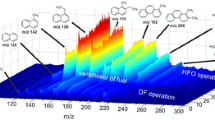Abstract
A new method of simultaneously recording NO and NO2 concentrations in complex gas mixtures is described. This method is based on resonance enhanced multiphoton ionization (REMPI), on time-of-flight mass analysis, and on monitoring the kinetic energy released upon dissociation of NO2. Its benefits are high speed and high flexibility. NO/NO2 analysis can therefore be combined with the simultaneous monitoring of other components. For instance, NH3 is a compound of interest when studying the chemical reactions of NOx in catalytic converters of combustion engines. The spectroscopic excitation schemes used for this new method are discussed in detail. Its reliability has been demonstrated by performing measurements at an industrial motor test facility. This novel technique performs well in comparison with conventional NOx analysis using chemiluminescence detection.

NOx-analysis of Diesel engine exhaust. Simultaneous fast detection of NO and NO2 by LAMS (laser mass spectrometry). Comparison of LAMS(NOx) with conventional CLD (chemiluminescence detection)








Similar content being viewed by others
Notes
The F+ fragment ion spectrum of molecule M is the spectrum obtained when exciting M while tuning the laser wavelength and monitoring F+ions
This test facility is run by the University of Applied Sciences in Landshut, Germany in cooperation with BMW-Munich
References
Yienger JJ, Klonecki AA, Levy H, Moxim WJ, Carmichael GRJ (1999) Geophys Res Atmos 104:3655
Peckham M, Hands T, Burrell JD, Collings N, Schurow SM (1998) SAE Technical Paper Series 980400
Simeonsson JB, Elwood SA, Niebes M, Carter R, Peck A (1999) Anal Chim Acta 397:33
Thornton JA, Woodridge PJ, Cohen RC (2000) Anal Chem 72:528
Bräumer EWA, Sick V, Wolfrum J, Drewes V, Maly RR, Zahn M (1995) SAE Technical Paper Series 952461
Boesl U, Neusser HJ, Schlag EW (1978) Z Naturforsch A33:1546
Bernstein RB (1982) J Phys Chem 86:1178
Cotter R (1984) Anal Chem 56:485A
Lubman D (1984) Anal Chem 56:1256A
Letokhov V (1987) Laser photoionization spectroscopy. Academic, New York
Lubman D (1990) Lasers in mass spectrometry. Oxford University Press, New York
Kompa K, Sick V, Wolfrum VJ (eds) (1993) Laser diagnostics for industrial processes (Special Issue). Ber Bunsen Phys Chem 97
Schlag EW (ed) (1994) Time-of-flight mass spectrometry and its applications (Special Issue). Int J Mass Spectrom 131
Boesl U (2000) J Mass Spectrom 35:289
Boesl U, Heger HJ, Zimmermann R, Püffel PK, Nagel H (2000) In: Meyers RA (ed) Encyclopedia of chemical analysis. Wiley, Chichester, UK, p 2087
Boesl U (2004) In: Hering P, Lay JP, Stry S (eds) Lasers in environmental and life sciences. Springer, Berlin Heidelberg New York, p 165
Zacharias H, Rottke H, Welge KH (1981) Appl Phys 24:23
Garnica RM, Appel MF, Eagan L, McKeachie JR, Benter T (2000) Anal Chem 72:5639
McKeachie JB, van der Veer WE, Short LC, Garnica RM, Apple MF, Benter T (2001) Analyst 126:1221
Ledingham KWD, Kosmidis C, Georgiou S, Couris S, Singhal RP (1995) Chem Phys Lett 247:555
Singhal RP, Kilic HS, Ledingham KWD, Kosmidis C, McCanny T, Langley AJ, Shaikh W (1996) Chem Phys Lett 253:81
Davies JA, LeClaire JE, Continetti RE, Hayden CC (1999) J Chem Phys 111:1
Busch GE, Wilson KR (1972) J Chem Phys 56:3626
Busch GE, Wilson KR (1972) J Chem Phys 56:3638
Bigio L, Grant EW (1987) J Chem Phys 87:360
Bigio L, Grant EW (1987) J Chem Phys 88:1271
Ahmed M, Peterka D, Bracker AS, Vasyutinski OS, Suits AG (1999) J Chem Phys 110:4115
Richter RC, Khamaganov VI, Hynes AJ (2000) Chem Phys Lett 319:341
Schafer N, Tonokura K, Matsumi Y, Tasaki S, Kawasaki M (1991) J Chem Phys 95:6218
Im HS, Bernstein ER (2002) J Phys Chem A106:7565
Marshall A, Clark A, Ledingham KWD, Sander J, Singhal RP (1993) Int J Mass Spectrom 125:R21
Weickhardt C, Boesl U, Schlag EW (1994) Anal Chem 66:1062
Boesl U, Weishäupl R, Thiel W, Frey R (2005) SAE Technical Paper Series 2005-01-0679
Author information
Authors and Affiliations
Corresponding author
Rights and permissions
About this article
Cite this article
Bornschlegl, A., Weishaeupl, R. & Boesl, U. A new approach for fast, simultaneous NO/NO2 analysis: application of basic features of multiphoton-induced ionization and dissociation of NOx . Anal Bioanal Chem 384, 161–168 (2006). https://doi.org/10.1007/s00216-005-0151-1
Received:
Revised:
Accepted:
Published:
Issue Date:
DOI: https://doi.org/10.1007/s00216-005-0151-1




